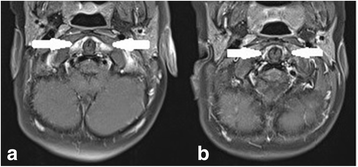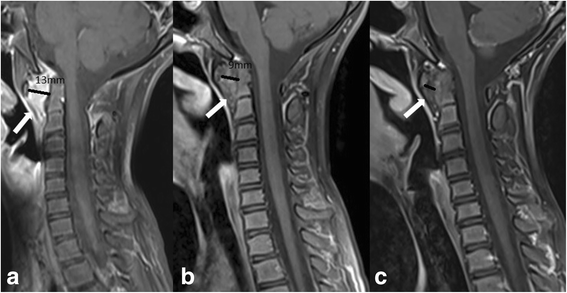Clinical and MRI outcome of cervical spine lesions in children with juvenile idiopathic arthritis treated with anti-TNFα drugs early in disease course
- PMID: 28506237
- PMCID: PMC5433237
- DOI: 10.1186/s12969-017-0173-1
Clinical and MRI outcome of cervical spine lesions in children with juvenile idiopathic arthritis treated with anti-TNFα drugs early in disease course
Abstract
Backgrounds: The purpose of the study was to evaluate the clinical and magnetic resonance imaging (MRI) outcome of cervical spine arthritis in children with juvenile idiopathic arthritis (JIA), who received anti-TNFα early in the course of cervical spine arthritis.
Methods: Medical charts and imaging of JIA patients with cervical spine involvement were reviewed in this retrospective study. Data, including age at disease onset, JIA type, disease activity, treatment and clinical outcome were collected. Initial and followup MRI examinations of cervical spine were performed according to the hospital protocol to evaluate the presence of inflammation and potential chronic/late changes.
Results: Fifteen JIA patients with MRI proved cervical spine inflammation (11 girls, 4 boys, median age 6.3y) were included in the study: 9 had polyarthritis, 3 extended oligoarthritis, 2 persistent oligoarthritis and 1 juvenile psoriatic arthritis. All children were initially treated with high-dose steroids and methotrexate. In addition, 11 patients were treated with anti-TNFα drug within 3 months, and 3 patients within 7 months of cervical spine involvement confirmed by MRI. Mean observation time was 2.9y, mean duration of anti-TNFα treatment was 2.2y. Last MRI showed no active inflammation in 12/15 children, allowing to stop biological treatment in 3 patients, and in 3/15 significant reduction of inflammation. Mild chronic changes were found on MRI in 3 children.
Conclusions: Early treatment with anti-TNFα drugs resulted in significantly reduced inflammation or complete remission of cervical spine arthritis proved by MRI, and prevented the development of serious chronic/late changes. Repeated MRI examinations are suggested in the follow-up of JIA patients with cervical spine arthritis.
Keywords: Anti-TNFα; Cervical spine arthritis; Juvenile idiopathic arthritis; Magnetic resonance; Outcome.
Figures


Similar articles
-
Cervical spine involvement in patients with juvenile idiopathic arthritis - MRI follow-up study.Pediatr Rheumatol Online J. 2014 Mar 4;12:9. doi: 10.1186/1546-0096-12-9. Pediatr Rheumatol Online J. 2014. PMID: 24593886 Free PMC article.
-
Clinical outcomes after withdrawal of anti-tumor necrosis factor α therapy in patients with juvenile idiopathic arthritis: a twelve-year experience.Arthritis Rheum. 2011 Oct;63(10):3163-8. doi: 10.1002/art.30502. Arthritis Rheum. 2011. PMID: 21702011
-
One-year followup study on clinical findings and changes in magnetic resonance imaging-based disease activity scores in juvenile idiopathic arthritis.J Rheumatol. 2014 Jan;41(1):119-27. doi: 10.3899/jrheum.130235. Epub 2013 Dec 1. J Rheumatol. 2014. PMID: 24293575
-
Juvenile Idiopathic Arthritis: Oligoarthritis and Polyarthritis.Pediatr Clin North Am. 2018 Aug;65(4):657-674. doi: 10.1016/j.pcl.2018.03.005. Pediatr Clin North Am. 2018. PMID: 30031492 Review.
-
Medical treatment of juvenile idiopathic arthritis.JAMA. 2005 Oct 5;294(13):1671-84. doi: 10.1001/jama.294.13.1671. JAMA. 2005. PMID: 16204667 Review.
Cited by
-
Advances in Musculoskeletal Imaging in Juvenile Idiopathic Arthritis.Biomedicines. 2022 Sep 27;10(10):2417. doi: 10.3390/biomedicines10102417. Biomedicines. 2022. PMID: 36289680 Free PMC article. Review.
-
Radiographs and MRI of the Cervical Spine in Juvenile Idiopathic Arthritis: A Cross-Sectional Retrospective Study.J Clin Med. 2021 Dec 11;10(24):5798. doi: 10.3390/jcm10245798. J Clin Med. 2021. PMID: 34945094 Free PMC article.
-
Imaging assessment of children presenting with suspected or known juvenile idiopathic arthritis: ESSR-ESPR points to consider.Eur Radiol. 2020 Oct;30(10):5237-5249. doi: 10.1007/s00330-020-06807-8. Epub 2020 May 12. Eur Radiol. 2020. PMID: 32399709 Free PMC article. Review.
-
Insurance Status and Tumor Necrosis Factor Inhibitor Initiation Among Children With Juvenile Idiopathic Arthritis in the CARRA Registry.J Rheumatol. 2023 Aug;50(8):1047-1057. doi: 10.3899/jrheum.220871. Epub 2022 Dec 15. J Rheumatol. 2023. PMID: 36521922 Free PMC article.
-
The Features of Children with Juvenile Idiopathic Arthritis with Cervical Spine Involvement in the Data from a Retrospective Study Cohort.J Funct Morphol Kinesiol. 2025 Feb 15;10(1):68. doi: 10.3390/jfmk10010068. J Funct Morphol Kinesiol. 2025. PMID: 39982308 Free PMC article.
References
-
- Wolfs JF, Arts MP, Peul WC. Juvenile chronic arthritis and the craniovertebral junction in the paediatric patient: review of the literature and management considerations. Adv Tech Stand Neurosurg. 2014;41:143–156. - PubMed
MeSH terms
Substances
LinkOut - more resources
Full Text Sources
Other Literature Sources
Medical

